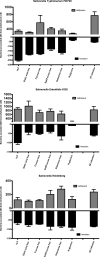Glycosylation of human milk lactoferrin exhibits dynamic changes during early lactation enhancing its role in pathogenic bacteria-host interactions
- PMID: 22261723
- PMCID: PMC3433903
- DOI: 10.1074/mcp.M111.015248
Glycosylation of human milk lactoferrin exhibits dynamic changes during early lactation enhancing its role in pathogenic bacteria-host interactions
Abstract
Human milk lactoferrin (hmLF) is the most abundant glycoprotein present in human milk and displays a broad range of protective functions in the gut of newborn infants. hmLF is N-glycosylated, but little is known about the lactation stage-related development of the glycosylation phenotype. hmLF glycosylation from milk samples from five donors during the first 10 weeks of lactation was assessed and observed to be more diverse than previously reported. During this period dynamic changes in glycosylation were observed corresponding to a decrease in glycosylation in the second week followed by an increase in total glycosylation as well as higher order fucosylation thereafter. Gene expression analysis was performed in milk somatic cells from a sixth subject. It was found that fucosyltransferase expression increased during entire period, whereas expression of genes for the oligosaccharyl transferase complex decreased in the second week. The effect of hmLF glycosylation was examined for the protein's ability to affect bacterial binding to epithelial cells. hmLF significantly inhibited pathogen adhesion and purified hmLF glycans significantly reduced Salmonella invasion of colonic epithelial cells to levels associated with non-invasive deletion mutants. This study indicates that hmLF glycosylation is tightly regulated by gene expression and that glyco-variation is involved in modulating pathogen association.
Figures




Similar articles
-
Glycoprotein expression in human milk during lactation.J Agric Food Chem. 2010 May 26;58(10):6440-8. doi: 10.1021/jf100112x. J Agric Food Chem. 2010. PMID: 20415418 Free PMC article.
-
Human Milk Proteins and Their Glycosylation Exhibit Quantitative Dynamic Variations during Lactation.J Nutr. 2019 Aug 1;149(8):1317-1325. doi: 10.1093/jn/nxz086. J Nutr. 2019. PMID: 31098625 Free PMC article.
-
Changes in glycosylation of human bile-salt-stimulated lipase during lactation.Arch Biochem Biophys. 2000 May 15;377(2):246-54. doi: 10.1006/abbi.2000.1778. Arch Biochem Biophys. 2000. PMID: 10845701
-
Studying Lactoferrin N-Glycosylation.Int J Mol Sci. 2017 Apr 20;18(4):870. doi: 10.3390/ijms18040870. Int J Mol Sci. 2017. PMID: 28425960 Free PMC article. Review.
-
Sugar coating: bacterial protein glycosylation and host-microbe interactions.Trends Biochem Sci. 2015 Jul;40(7):342-50. doi: 10.1016/j.tibs.2015.03.016. Epub 2015 Apr 30. Trends Biochem Sci. 2015. PMID: 25936979 Review.
Cited by
-
Lactoferrin as a Human Genome "Guardian"-An Overall Point of View.Int J Mol Sci. 2022 May 8;23(9):5248. doi: 10.3390/ijms23095248. Int J Mol Sci. 2022. PMID: 35563638 Free PMC article. Review.
-
Lactoferrin in Aseptic and Septic Inflammation.Molecules. 2019 Apr 3;24(7):1323. doi: 10.3390/molecules24071323. Molecules. 2019. PMID: 30987256 Free PMC article. Review.
-
Time to Kill and Time to Heal: The Multifaceted Role of Lactoferrin and Lactoferricin in Host Defense.Pharmaceutics. 2023 Mar 24;15(4):1056. doi: 10.3390/pharmaceutics15041056. Pharmaceutics. 2023. PMID: 37111542 Free PMC article. Review.
-
Characterization of N- and O-linked glycosylation changes in milk of the tammar wallaby (Macropus eugenii) over lactation.Glycoconj J. 2013 Jul;30(5):523-36. doi: 10.1007/s10719-012-9452-8. Epub 2012 Oct 10. Glycoconj J. 2013. PMID: 23053637
-
Human milk secretory immunoglobulin a and lactoferrin N-glycans are altered in women with gestational diabetes mellitus.J Nutr. 2013 Dec;143(12):1906-12. doi: 10.3945/jn.113.180695. Epub 2013 Sep 18. J Nutr. 2013. PMID: 24047700 Free PMC article.
References
-
- Lönnerdal B., Lien E. L. (2003) Nutritional and physiologic significance of alpha-lactalbumin in infants. Nutr. Rev. 61, 295–305 - PubMed
-
- Kaufman D. A. (2009) Lactoferrin supplementation to prevent nosocomial infections in preterm infants. JAMA 302, 1467–1468 - PubMed
-
- Venkatesh M. P., Rong L. (2008) Human recombinant lactoferrin acts synergistically with antimicrobials commonly used in neonatal practice against coagulase-negative staphylococci and Candida albicans causing neonatal sepsis. J. Med. Microbiol. 57, 1113–1121 - PubMed
-
- Spik G., Strecker G., Fournet B., Bouquelet S., Montreuil J., Dorland L., van Halbeek H., Vliegenthart J. F. (1982) Primary structure of the glycans from human lactotransferrin. Eur. J. Biochem. 121, 413–419 - PubMed
Publication types
MeSH terms
Substances
Grants and funding
LinkOut - more resources
Full Text Sources
Other Literature Sources
Medical
Miscellaneous

